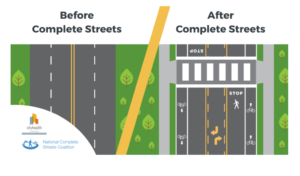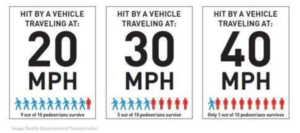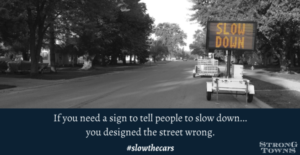Guest commentary by Joel Arnold,
Planning and Advocacy Manager at Communities First, Inc.
If there’s one thing we hear regularly in our city and region, it’s that people drive far too fast and far too dangerously.
In the Flint area, we’ve seen business after business — whether a fast-food restaurant on Dort Highway, Mega Coney Island in Flint Township, or even Dawn Donuts on Clio Road — get hit by vehicles.
A consistent theme in all these incidents is that they take place on roads designed for one thing: moving cars as fast as possible. But what if we considered more than just the drivers on our roads, like bikers or pedestrians? And what if we made space for them?
Throughout the US, there has been a growing movement to adopt what are called “Complete Streets.”
As defined by Smart Growth America, “Complete Streets are streets for everyone. Complete Streets is an approach to planning, designing, building, operating, and maintaining streets that enables safe access for all people who need to use them, including pedestrians, bicyclists, motorists and transit riders of all ages and abilities.” In short, this means making our streets easy to use whether you are walking, biking, using public transportation, using a wheelchair, or driving. Smart Growth America’s Complete Streets Coalition has even created a handy image to show what such streets can look like.

(Graphic source: smartgrowthamerica.org)
Today in Flint, we have many roads that were designed using a different concept known as “Levels of Service,” or LOS. LOS rates the quality of a road based on one thing: the speed and smoothness through which vehicles flow through a road. It’s a measure that does not account for pedestrians, cyclists, bus passengers waiting at a stop, or others traveling along the road. While many of us drive here in the Vehicle City, it’s also true that thousands of Flint residents don’t drive or don’t have access to a vehicle. According to the US Census Bureau, nearly 25% of workers in Flint get to their jobs in a way other than driving by themselves. In particular, Black and Hispanic households are less likely to own a vehicle than white households.
However, the most important reason to embrace a Complete Streets worldview is a simple reason – safety.
Our current roads are incredibly unsafe. According to The Crim Fitness Foundation’s Neighborhood Impact Department, since 2012 there have been 453 pedestrian-involved vehicle crashes in the City of Flint, involving more than 1,000 pedestrians and leading to 105 fatalities. An additional 296 bicyclists have been hit, with 7 losing their lives. That’s 112 lives lost to these crashes in our communities.
Additionally, data shows that low-income individuals have the highest rates of walking and bicycling to work, and are less likely to have access to a personal vehicle. Making changes to our roadways thus is not simply a way to make different modes of transportation safer, but a critical means of advancing social equity. The faster cars move through our city, the more at risk pedestrians are if they are hit.

(Graphic source: The Seattle Department of Transportation)
Thankfully, Flint is poised for change.
Currently the city has a vacancy in the Department of Public Works Director position. This position oversees Flint’s transportation investments and the decisions made on how our roads get designed. The City should seek to hire someone well-versed in Complete Streets and committed to better, safer road design.
The City of Flint could also adopt a Complete Streets Ordinance, making it city law to require that all road repairs include the needs of all travelers, regardless of whether they drive.
Cities around the Midwest from Milwaukee, Wisconsin to Cleveland Heights, Ohio have already adopted ordinances like this, and Complete Streets designs have now made their way to cities in our own state — in Ann Arbor, Kalamazoo, and Detroit. There’s no reason we can’t adopt a Complete Streets ordinance as well.
What might this look like in real life? It would look like more bike lanes protected by bollards or curbs. It would mean more clearly marked crosswalks. It would mean narrower roads that encourage slower, safer driving. Most importantly, it would look like Flint residents of all races and incomes being able to get to work, school, the doctor, and visits with friends in a safe and convenient way, no matter how they move.

(Graphic source: strongtowns.org)
There’s no time to waste in building a safer city. Let’s take advantage of the opportunity we have and get to building.
Joel Arnold is the Planning and Advocacy Manager at Communities First, Inc., a Flint-based nonprofit committed to building healthy, vibrant communities through economic development, affordable housing, and innovative programming. He is also a co-founder of Flint Residents for Stronger Neighborhoods, a resident group whose mission is to advocate for quality, effective urbanism in the City of Flint. He is a proud resident of the Central Park neighborhood and can be reached at jarnold@communitiesfirstinc.org.


You must be logged in to post a comment.